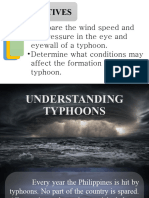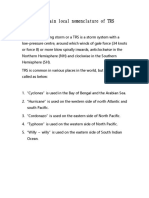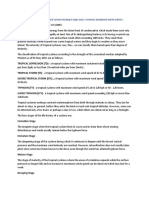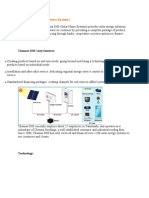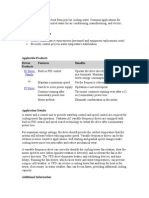Cyclones
Cyclones
Uploaded by
Saravanapriya KarthikCopyright:
Available Formats
Cyclones
Cyclones
Uploaded by
Saravanapriya KarthikOriginal Description:
Copyright
Available Formats
Share this document
Did you find this document useful?
Is this content inappropriate?
Copyright:
Available Formats
Cyclones
Cyclones
Uploaded by
Saravanapriya KarthikCopyright:
Available Formats
TYPES OF CYCLONES Cyclones are defined as ``an atmospheric system in which the barometric pressure diminishes progressively to a minimum
at the centre and toward which the winds blow spirally inward from all sides, resulting in a lifting of the air and eventually in clouds and precipitation''. A cyclone is a violent tropical storm that occurs in the Indian Ocean or the South western portion of the Pacific Ocean. The formation, strengthening, or regeneration of a cyclone is called cyclogenesis, while the weakening or dissipation of a cyclone is called cyclolysis. The former is associated with deepening while the latter is associated with filling of a low pressure center. The winds usually form over the equator or in a tropical location and rotate at an extremely high speed. There are different types of cyclones depending on where they make landfall. They are usually referred to as tropical cyclones. A cyclone that occurs in the North western portion of the Pacific Ocean is called a typhoon. It is a weather system characterized by swirling winds and raging storms. About Ecuador, a cyclone is particularly vulnerable because of their potential property damage and cause heavy rainfall, especially if it becomes a hurricane. The science behind hurricanes will help you understand why, where and how time there. It is an area of low pressure with winds blowing counter clockwise around it in the Northern Hemisphere and clockwise around it in the southern hemisphere. A tropical cyclone is a cyclone which forms in the tropics. Cyclones are caused by atmospheric disturbances around a low-pressure area distinguished by swift and often destructive air circulation. They are usually accompanied by violent storms and bad weather. The air circulates inward in an anticlockwise direction in the northern hemisphere and clockwise in the southern hemisphere. Cyclones are classified as: (i) extra tropical cyclones (also called temperate cyclones); and (ii) tropical cyclones. The World Meteorological Organisation (WMO, 1976) uses the term tropical cyclone to cover weather systems in which winds exceed gale force (minimum of 34 knots or 63 Kph). Tropical cyclones are given different names to show how fast their winds are. Here is a list of the different names gives to the storms:
Tropical disturbance: Winds weak and unorganized Tropical depression: Winds less than 39 mph Tropical storm: Winds 39 to 74 mph Hurricane: Winds greater than 74 mph
You might also like
- IN Earth Science (Cyclone)Document9 pagesIN Earth Science (Cyclone)Otsenre Cari Otiralab100% (1)
- CyclonesDocument8 pagesCyclonesbaljitNo ratings yet
- Tropical Revolving Storms or Tropical Cy PDFDocument16 pagesTropical Revolving Storms or Tropical Cy PDFNitin KafleNo ratings yet
- Tropical CycloneDocument11 pagesTropical CycloneGilbert G. TrillanesNo ratings yet
- Tropical CycloneDocument12 pagesTropical CycloneDe GuzmanNo ratings yet
- ENG - Tornados - Doce197dDocument3 pagesENG - Tornados - Doce197dAaron WolfeNo ratings yet
- What Are Cyclones?Document42 pagesWhat Are Cyclones?Managsha ChibhishaNo ratings yet
- Unit 4Document15 pagesUnit 4Imran Ul haq (Ammar choudhary)No ratings yet
- CycloneDocument8 pagesCyclonebiprasarker2No ratings yet
- 2 Updated CYCLONESDocument8 pages2 Updated CYCLONESPresiNo ratings yet
- Understanding TyphoonsDocument53 pagesUnderstanding TyphoonsMikaela KayeNo ratings yet
- TropicalDocument14 pagesTropicallieselbrown81No ratings yet
- TROPICALDocument14 pagesTROPICALzahidfazal1926No ratings yet
- Tropical Cyclone and Temperate CyclonesDocument12 pagesTropical Cyclone and Temperate Cyclonesadsites863No ratings yet
- Research Paper 3Document2 pagesResearch Paper 3swatiNo ratings yet
- Explain Local Nomenclature of TRSDocument50 pagesExplain Local Nomenclature of TRSLizette CruzNo ratings yet
- Hurricanes, Tropical WavesDocument17 pagesHurricanes, Tropical WavesAngel AxonNo ratings yet
- Weather Disturbances: Hurricane, Tropical Cyclone, Typhoon, Tornado, Cyclone, StormDocument10 pagesWeather Disturbances: Hurricane, Tropical Cyclone, Typhoon, Tornado, Cyclone, StormNick TejadaNo ratings yet
- Types of Weather DisturbancesDocument21 pagesTypes of Weather DisturbancesJasmin marie MelendezNo ratings yet
- Hirricanetyphoon CycloneDocument7 pagesHirricanetyphoon CycloneNoli UssihNo ratings yet
- TyphoonDocument2 pagesTyphoonaradillaicielveniaNo ratings yet
- Met-O ReportDocument9 pagesMet-O ReportMarioNo ratings yet
- CYCLONEDocument20 pagesCYCLONEkhushboo sharmaNo ratings yet
- CycloneDocument10 pagesCycloneblurbNo ratings yet
- Natural Hazards Cyclones 2Document8 pagesNatural Hazards Cyclones 2anithaNo ratings yet
- Original Coriolis PDFDocument10 pagesOriginal Coriolis PDFTito Robles JrNo ratings yet
- Weather DisturbancesDocument18 pagesWeather DisturbancesEunice Bawaan DomineNo ratings yet
- Hydrometeorological HazardsDocument12 pagesHydrometeorological HazardsMARGARITA MARIANONo ratings yet
- Causes of Cyclone (Lianah)Document4 pagesCauses of Cyclone (Lianah)Kudzanai MuchatoraNo ratings yet
- CYCLONESDocument11 pagesCYCLONESMaha MusicalsNo ratings yet
- Tropical CycloneDocument55 pagesTropical CyclonePaul SimonNo ratings yet
- Tropical Refers To The Geographical Origin of These Systems, Which Form Almost ExclusivelyDocument1 pageTropical Refers To The Geographical Origin of These Systems, Which Form Almost ExclusivelyradwanNo ratings yet
- Question From Sally Lee: What Causes A Hurricane? Why Is A Hurricane So Destructive?Document9 pagesQuestion From Sally Lee: What Causes A Hurricane? Why Is A Hurricane So Destructive?Muhammad EhsanNo ratings yet
- MeteorologyDocument25 pagesMeteorologyJosephine TsangNo ratings yet
- Defination: CyclonesDocument31 pagesDefination: CyclonesprachiNo ratings yet
- Cyclone:: Cyclone, Types, Effects and Formation of CycloneDocument3 pagesCyclone:: Cyclone, Types, Effects and Formation of CycloneprachiNo ratings yet
- 21 Tropical CyclonesDocument14 pages21 Tropical CyclonesLuisa LouisaNo ratings yet
- Cyclone: Polar Low Over The On February 27, 1987Document8 pagesCyclone: Polar Low Over The On February 27, 1987harshatheresaNo ratings yet
- STORMDocument3 pagesSTORMKenny Manuel VettoorNo ratings yet
- Meteorology CYCLONES BSCDocument57 pagesMeteorology CYCLONES BSCjaysonNo ratings yet
- CycloneDocument2 pagesCycloneArbieNo ratings yet
- Lesson Weather DisturbancesDocument12 pagesLesson Weather DisturbancesVer BienNo ratings yet
- Cyclones 170306080858Document47 pagesCyclones 170306080858Arciete Dyr100% (2)
- Hurricanes and Torenadoes NEWDocument18 pagesHurricanes and Torenadoes NEWAdrian QuiambaoNo ratings yet
- Definition and CharacteristicsDocument1 pageDefinition and CharacteristicsWawie Martirez JulomNo ratings yet
- CycloneDocument7 pagesCycloneBarbara SnehaNo ratings yet
- Tropical Refers To The Geographical Origin of These Systems, Which Form AlmostDocument1 pageTropical Refers To The Geographical Origin of These Systems, Which Form AlmostFong CaiNo ratings yet
- CyclonesDocument15 pagesCyclonesLakshay VermaNo ratings yet
- Cyclone Upsc Notes 16Document3 pagesCyclone Upsc Notes 16rakeshxtra1No ratings yet
- clearias.com-Cyclones vs AnticyclonesDocument8 pagesclearias.com-Cyclones vs AnticyclonesMegha TayalNo ratings yet
- Quarter 2 Module 4 Understanding TyphoonDocument2 pagesQuarter 2 Module 4 Understanding Typhoonperrypetersonramos38No ratings yet
- 1.determine The Classification of Tropical Cyclones Including Its Origin, Tracks, Movement, Development and The StatisticsDocument6 pages1.determine The Classification of Tropical Cyclones Including Its Origin, Tracks, Movement, Development and The StatisticsJohn Carlo De LunaNo ratings yet
- Meteorological HazardsDocument3 pagesMeteorological Hazardsjames_chong_16No ratings yet
- Cyclone: Northeast Monsoon (Amihan)Document2 pagesCyclone: Northeast Monsoon (Amihan)Nea MendezNo ratings yet
- Cyclone: Refers To Any Spinning Storm That Rotates Around A Low-Pressure CenterDocument1 pageCyclone: Refers To Any Spinning Storm That Rotates Around A Low-Pressure CenterSebastian Guerra DiazNo ratings yet
- Cyclones and AnticyclonesDocument2 pagesCyclones and AnticyclonessdasdaNo ratings yet
- Cyclone FinalDocument53 pagesCyclone FinalAMINA JADOONNo ratings yet
- Natural Hazards-Cyclones: September 2005Document8 pagesNatural Hazards-Cyclones: September 2005Habibur RahmanNo ratings yet
- Energy Storage For Sustainable SystemsDocument7 pagesEnergy Storage For Sustainable SystemsSaravanapriya KarthikNo ratings yet
- Flash Pyrolysis NewDocument14 pagesFlash Pyrolysis NewSaravanapriya Karthik100% (1)
- About Chennai Solar Home Systems: Chennai SHS's Key FeaturesDocument16 pagesAbout Chennai Solar Home Systems: Chennai SHS's Key FeaturesSaravanapriya KarthikNo ratings yet
- Application Challenges: E7 Drive FamilyDocument11 pagesApplication Challenges: E7 Drive FamilySaravanapriya KarthikNo ratings yet
- TRANS WP29 GRPE 42 Inf18 PDFDocument2 pagesTRANS WP29 GRPE 42 Inf18 PDFppkakamariNo ratings yet
- 3.8.8 Instrument For Measuring Vibration and NoiseDocument4 pages3.8.8 Instrument For Measuring Vibration and NoiseSaravanapriya KarthikNo ratings yet
- Defining Drag & Lift ForcesDocument9 pagesDefining Drag & Lift ForcesSaravanapriya KarthikNo ratings yet
- The Explained Variation by Lignin and Extractive Contents On Higher Heating Value of WoodDocument4 pagesThe Explained Variation by Lignin and Extractive Contents On Higher Heating Value of WoodSaravanapriya KarthikNo ratings yet
- Pyranometer Vs PyrheliometerDocument1 pagePyranometer Vs PyrheliometerSaravanapriya KarthikNo ratings yet
- Result: Usefull Heat Gain 3750 Kcal/hrDocument1 pageResult: Usefull Heat Gain 3750 Kcal/hrSaravanapriya KarthikNo ratings yet
- Random number Probability Z value X = Zσ + mean: Models with Uncertainty (Stochastic Modeling)Document43 pagesRandom number Probability Z value X = Zσ + mean: Models with Uncertainty (Stochastic Modeling)Saravanapriya KarthikNo ratings yet
- Design of Water Pumping Windmill: From Manufacturer's TableDocument2 pagesDesign of Water Pumping Windmill: From Manufacturer's TableSaravanapriya KarthikNo ratings yet
- Fuel Properties TablesDocument11 pagesFuel Properties TablesSaravanapriya KarthikNo ratings yet
- Water HeaterDocument1 pageWater HeaterSaravanapriya KarthikNo ratings yet
- Solenoid ValveDocument3 pagesSolenoid ValveSaravanapriya Karthik0% (1)
- Spectro Photo Me TryDocument5 pagesSpectro Photo Me TrySaravanapriya KarthikNo ratings yet
- Water PumpingDocument1 pageWater PumpingSaravanapriya KarthikNo ratings yet
- Proximate N Ultimate AnalysisDocument12 pagesProximate N Ultimate AnalysisSaravanapriya Karthik50% (2)










